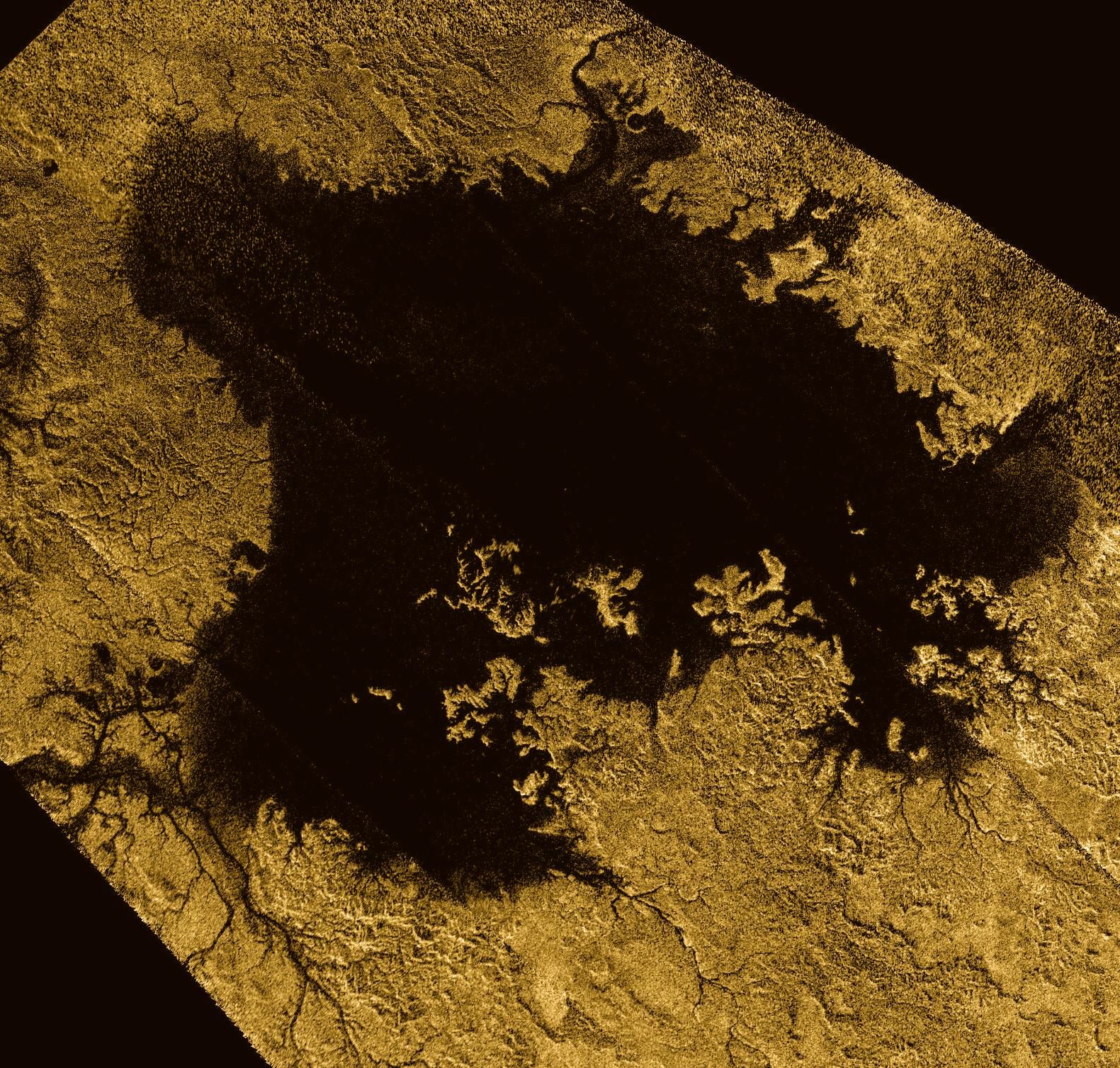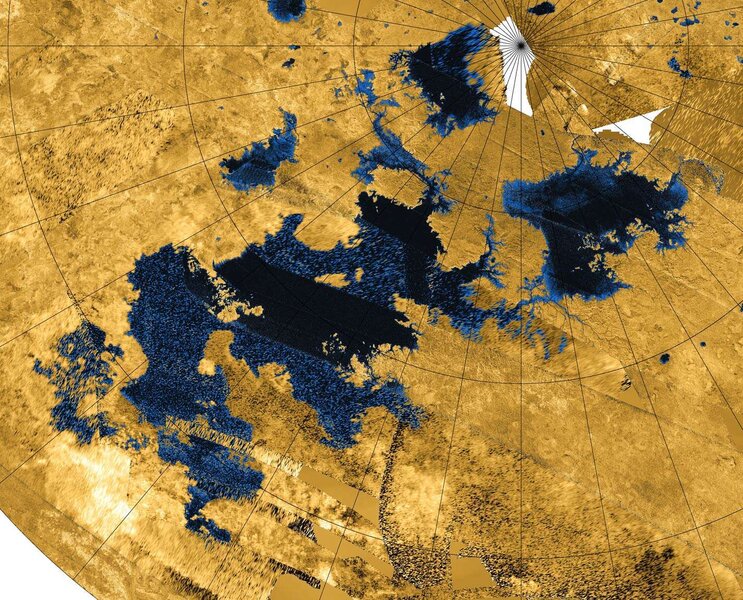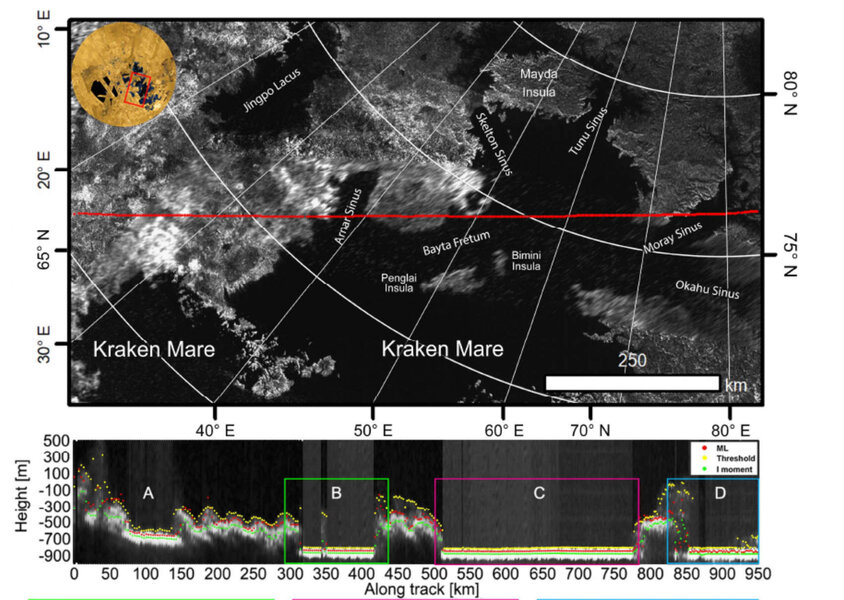Create a free profile to get unlimited access to exclusive videos, sweepstakes, and more!
Release the Kraken! Huge methane lakes on Saturn's moon Titan run deep.

The Cassini mission was a triumph of science and human imagination. Orbiting Saturn for 13 years, it sent back incredible images and data of the ringed world and its fleet of bizarre moons.
Listing the top scientific accomplishments and discoveries would fill an encyclopedia, but no such list would be complete without talking at length about the discovery of lakes of liquid methane near Titan's north pole.
They had been predicted to exist, but the evidence Cassini sent Earthward was still stunning: Huge lakes, some the size of the Great Lakes in North America, complete with tributaries feeding them coming off the surrounding hills. And Kraken Mare, the largest, is 5 times larger than Lake Superior by area.
And it turns out to be quite deep, as well. New analysis of Cassini data shows it is at least 100 meters deep in the main lake region, and possibly much more.
Titan is a world-sized moon, bigger than Mercury, with a nitrogen atmosphere so dense the pressure at the surface is 50% more than Earth's. But at a distance of 1.4 billion kilometers from the Sun, it's very very cold there. Water is frozen into ice harder than Earth rocks. However, methane, which is a gas on Earth, can be either gaseous, liquid, or solid on Titan depending on the local weather.
So lakes were predicted, and Cassini used radar to map them. Radar pulses from the spacecraft go right through the atmosphere and bounce off the ground back up to the spacecraft. But liquid methane absorbs them, so radar images of the surface show the lakes as dark.
But it takes a certain amount of methane to completely absorb the radar. A puddle won't do it, but a deep lake will.
Kraken Mare (literally, Kraken Sea) is a huge lake near the north pole of Titan. Cassini pinged it with radar many times. On one such pass, the track of the radar went over land, then the main part of Kraken Mare, and then a bay called Moray Sinus (no, not the nose of the eel; sinus means bay, and the name comes from the Scottish firth). As the radar pulses pass through the liquid they get attenuated, fainter, before reflecting back up to Cassini. By measuring the attenuation the depth can be measured.
The scientists found that Moray Sinus has a depth of about 85 meters, which is impressive. But over the main body of Kraken Mare they got no reflected pulse at all. Local conditions can make it hard to know exactly how much radar is absorbed by the liquid (for example, if the surface is rough with waves, which is actually likely) but the lower limit for their measurements is 100 meters. If conditions were actually good, then it means the depth is at least 300 meters.
Even 100 meters is quite deep. The average depth of Lake Superior is about 150 meters, so they're at least about the same, though Kraken Mare may yet be much deeper. Remember, too, Kraken Mare is far larger than Lake Superior, so it has a lot more liquid in it.
That's amazing. In fact, it's pegged my "amazing" meter. First, lakes on Titan! Second, liquid methane lakes on titan! Third, lakes of liquid methane on Titan that are fed from streams and rivers meaning there's a methane cycle on Titan like the water cycle on Earth!
And now we find that the lakes aren't just shallow puddles, but instead seriously deep bodies that contain a vast amount of liquid.
Titan is a moon only by dint of it orbiting Saturn. Otherwise we might rightly consider it a planet, an enormous world that may be as richly environmentally diverse as our own.
I've seen Titan myself through the eyepiece, a dot of light aligned with Saturn's rings. Under many conditions it's the only other thing you can see near Saturn, though the other moons are usually visible much more faintly. Still, to have light from this distant world travel all the way here and into my eye is always a delight.
But now when I see it, I will know so much more about it. The maria of Titan are not just shallow pools but mighty lakes, enormous and rough and sculpting the land around them, the equal of any such body of water on Earth.





























